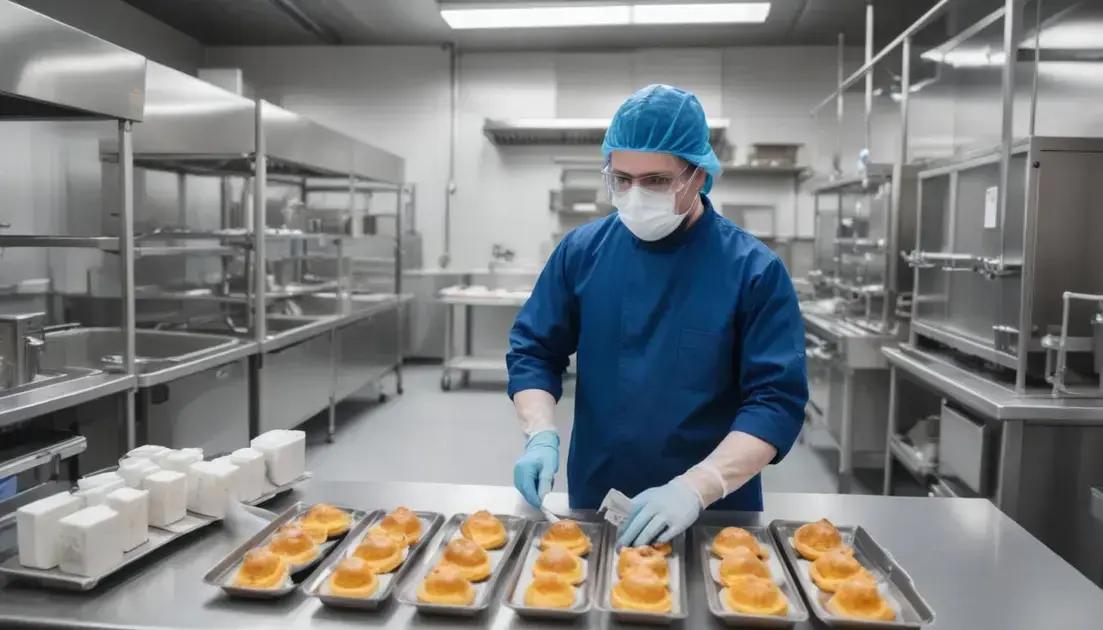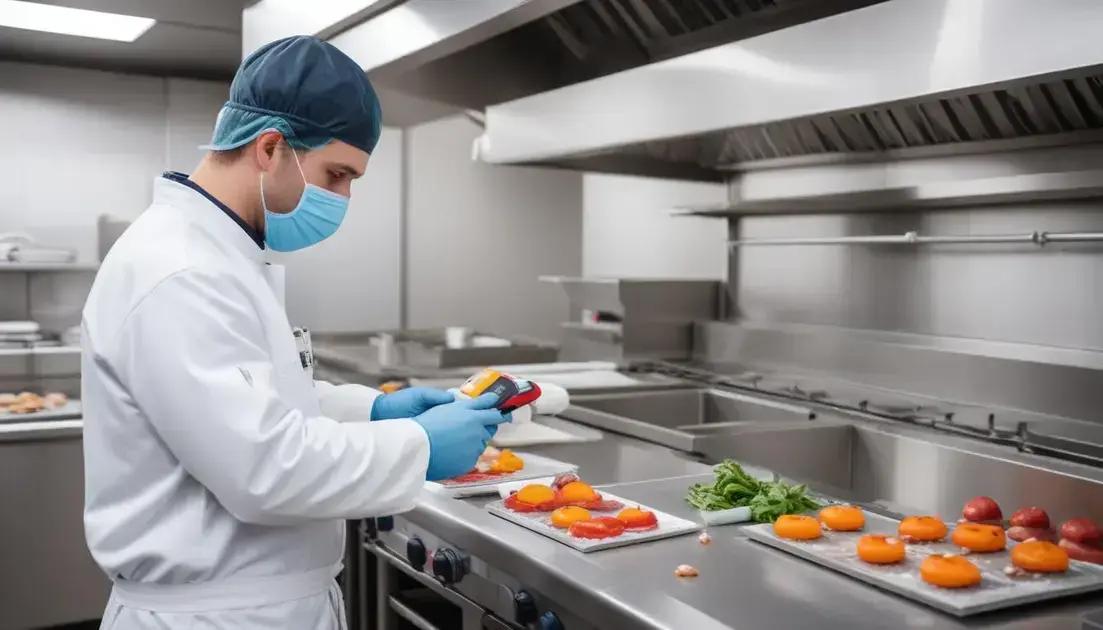CCP safety standards: critical control points that protect your food safety

CCP safety standards represent a cornerstone of modern food safety, offering a systematic approach to preventing contamination and protecting consumer health. By identifying and controlling potential risks at critical points in food production, businesses can significantly reduce the likelihood of foodborne illnesses and maintain high-quality standards.
Understanding critical control points (ccps)
Critical Control Points (CCPs) are specific stages in food production where potential hazards can be prevented, eliminated, or reduced to acceptable levels. These crucial checkpoints are fundamental to the Hazard Analysis and Critical Control Points (HACCP) system, which ensures food safety throughout the entire production process.
Key Components of Critical Control Points
CCPs are typically identified by analyzing potential biological, chemical, and physical risks that could contaminate food. These risks might include temperature ranges, potential microbial growth, cross-contamination possibilities, or chemical exposure during manufacturing.
Risk Assessment in CCPs
Food safety professionals use a systematic approach to determine where critical control points exist. This involves creating a detailed flow chart of the production process and evaluating each step for potential hazards that could compromise food quality and consumer health.
Examples of critical control points include refrigeration temperatures, cooking temperatures, cleaning and sanitization processes, and ingredient handling procedures. Each CCP requires specific monitoring protocols and corrective actions to maintain food safety standards.
Monitoring and Verification
Continuous monitoring of CCPs is essential. This involves regular temperature checks, microbial testing, visual inspections, and documentation to ensure that established safety thresholds are consistently met. Verification procedures help validate that the control measures are effective and functioning as intended.
By implementing robust CCP management, food production facilities can significantly reduce the risk of foodborne illnesses and maintain high-quality standards that protect consumer health and build trust in their products.
key principles of food safety management
Food safety management involves a comprehensive approach to preventing foodborne illnesses and ensuring product quality throughout the entire production process. The core principles focus on proactive risk management and systematic control strategies that protect consumer health.
Hazard Prevention and Risk Assessment
Effective food safety management begins with comprehensive hazard identification. This involves analyzing potential biological, chemical, and physical risks at each stage of food production. Professionals use detailed risk assessment tools to evaluate potential contamination sources and develop targeted prevention strategies.
Preventive Control Strategies
Implementing preventive controls is crucial in food safety management. This includes establishing strict hygiene protocols, maintaining proper temperature controls, and creating robust cleaning and sanitization procedures. Regular equipment maintenance and staff training play a critical role in minimizing contamination risks.
Key preventive measures include:
- Personal hygiene requirements
- Cross-contamination prevention
- Allergen management
- Supplier verification processes
Documentation and Traceability
Maintaining detailed documentation is a fundamental principle of food safety management. This includes comprehensive record-keeping of production processes, temperature logs, cleaning procedures, and staff training. Traceability systems enable quick identification and resolution of potential food safety issues, allowing for rapid response to any contamination concerns.
Advanced food safety management incorporates technology and data analysis to continuously improve safety protocols. By implementing systematic approaches and staying proactive, food production facilities can effectively mitigate risks and protect consumer health.
identifying potential hazards in food production
Identifying potential hazards in food production is a critical process that requires comprehensive analysis and systematic evaluation of risks that could compromise food safety. This involves a detailed examination of biological, chemical, and physical threats throughout the entire production chain.
Biological Hazards
Microbial contamination represents one of the most significant risks in food production. This includes identifying potential pathogens such as Salmonella, E. coli, and Listeria that can cause severe foodborne illnesses. Professionals use advanced detection methods like PCR testing and microbiological cultures to trace and prevent these biological threats.
Chemical Hazards
Chemical risks involve unexpected substances that might enter the food production process. These can include:
- Cleaning chemical residues
- Pesticide contamination
- Heavy metal presence
- Unintended chemical interactions
Physical Contamination Risks
Physical hazards involve external objects that could accidentally enter food products. These might include metal fragments, glass pieces, plastic particles, or other foreign materials that could cause injury or compromise food quality. Sophisticated detection systems like metal detectors and X-ray machines help identify these potential risks during production.
Advanced risk assessment techniques, including Hazard Analysis and Critical Control Points (HACCP) systems, enable food production facilities to create comprehensive risk management strategies. By systematically identifying and mitigating potential hazards, companies can ensure product safety and maintain consumer trust.
Implementing effective monitoring systems
Implementing effective monitoring systems is crucial for maintaining food safety standards and ensuring consistent product quality. These systems provide real-time tracking and verification of critical control points throughout the production process.
Technology-Driven Monitoring Approaches
Advanced sensor technologies have revolutionized monitoring systems, enabling continuous and precise tracking of environmental conditions. Digital monitoring tools can instantly detect temperature variations, humidity levels, and potential contamination risks, allowing immediate corrective actions.
Key Components of Monitoring Systems
Effective monitoring systems typically incorporate several essential elements:
- Real-time temperature tracking
- Automated data logging
- Instant alert mechanisms
- Comprehensive documentation protocols
Data Management and Analysis
Digital record-keeping and analytics play a critical role in modern monitoring systems. By collecting and analyzing production data, facilities can identify patterns, predict potential risks, and continuously improve their food safety strategies. Machine learning algorithms can help detect subtle variations that might indicate emerging quality control issues.
Successful monitoring systems require a combination of advanced technology, trained personnel, and robust standard operating procedures. Regular calibration of monitoring equipment, staff training, and continuous system evaluation are essential for maintaining high food safety standards and preventing potential contamination risks.
Temperature control and its importance

Temperature control is a critical aspect of food safety management, directly impacting product quality, shelf life, and consumer health. Maintaining precise temperature ranges prevents bacterial growth and ensures food remains safe throughout production and storage.
Temperature Danger Zone
The temperature range between 40°F and 140°F (4°C to 60°C) represents the critical zone where harmful bacteria multiply rapidly. Food safety protocols require strict monitoring and quick action to prevent prolonged exposure in this dangerous temperature range, which can lead to potential foodborne illness outbreaks.
Critical Temperature Control Points
Different food categories require specific temperature management strategies:
- Refrigerated foods: Below 40°F (4°C)
- Frozen products: 0°F (-18°C) or lower
- Hot prepared foods: Above 165°F (74°C)
- Cooling processes: Rapid reduction from hot to safe storage temperatures
Monitoring and Documentation
Advanced digital temperature monitoring systems enable continuous tracking and instant alerts when temperature deviations occur. These technologies provide real-time data logging, creating comprehensive records that demonstrate compliance with food safety regulations and enable quick corrective actions.
Effective temperature control requires a combination of proper equipment, trained personnel, and systematic verification processes. Regular calibration of thermometers, staff training, and adherence to established temperature management protocols are essential for maintaining food safety standards.
Documentation and record-keeping strategies
Effective documentation and record-keeping are fundamental to maintaining food safety standards, providing critical evidence of compliance and enabling continuous improvement in food production processes.
Essential Documentation Components
Comprehensive documentation encompasses multiple critical elements, including temperature logs, cleaning records, staff training certificates, supplier verification reports, and equipment maintenance schedules. These records serve as a comprehensive tracking system for quality control and regulatory compliance.
Digital Record Management Systems
Modern food safety management relies on advanced digital platforms that offer:
- Real-time data collection
- Automated reporting
- Cloud-based storage
- Instant accessibility for audits
Regulatory Compliance Documentation
Traceability documentation is crucial for tracking food products through every production stage. This includes batch numbers, production dates, ingredient sources, and distribution records. Such detailed documentation enables quick product recalls and demonstrates commitment to consumer safety.
Successful documentation strategies require consistent staff training, standardized recording protocols, and regular internal audits. By maintaining meticulous and organized records, food production facilities can effectively manage risks, demonstrate regulatory compliance, and continuously enhance their food safety practices.
Training staff on CCP protocols
Effective staff training on Critical Control Point (CCP) protocols is essential for maintaining food safety standards and preventing potential contamination risks in food production environments.
Comprehensive Training Components
Structured training programs should cover multiple critical aspects of food safety, including hazard identification, proper handling techniques, and immediate response protocols. These programs must be tailored to specific job roles and production processes, ensuring each staff member understands their unique responsibilities.
Key Training Methodology
Successful staff training incorporates several essential learning strategies:
- Interactive hands-on workshops
- Digital simulation scenarios
- Regular knowledge assessment tests
- Practical demonstration of safety protocols
Ongoing Education and Skill Development
Continuous learning mechanisms are crucial for maintaining high food safety standards. This involves periodic refresher courses, updates on new regulatory requirements, and advanced training sessions that help staff stay current with evolving food safety technologies and methodologies.
Effective CCP protocol training requires a combination of theoretical knowledge, practical skills, and a culture of safety awareness. By investing in comprehensive staff education, food production facilities can significantly reduce human error risks and maintain consistently high food safety standards.
Continuous improvement in safety standards
Continuous improvement in food safety standards represents a dynamic approach to maintaining and enhancing protection mechanisms within food production environments, focusing on proactive risk management and innovative strategies.
Data-Driven Improvement Strategies
Advanced analytical tools enable food safety professionals to track performance metrics, identify potential vulnerabilities, and develop targeted improvement protocols. This systematic approach transforms historical data into actionable insights that drive meaningful enhancements in safety practices.
Key Improvement Components
Effective continuous improvement strategies incorporate multiple critical elements:
- Regular performance audits
- Emerging technology integration
- Benchmarking against industry standards
- Comprehensive risk reassessment processes
Technology and Innovation
Technological innovations play a crucial role in advancing safety standards. Emerging technologies like artificial intelligence, machine learning, and advanced sensor systems provide unprecedented capabilities for detecting potential risks, predicting contamination patterns, and implementing preemptive control measures.
Successful continuous improvement requires a culture of learning, adaptability, and commitment to excellence. By embracing innovative approaches and maintaining a forward-thinking mindset, food production facilities can consistently elevate their safety standards, protect consumer health, and demonstrate industry leadership.
Safeguarding Food Production: A Comprehensive Approach to CCP Safety Standards
Critical Control Point (CCP) safety standards represent more than just a regulatory requirement—they are a comprehensive system designed to protect consumer health and maintain the highest quality in food production.
By implementing robust monitoring systems, utilizing advanced technologies, and fostering a culture of continuous improvement, food production facilities can effectively manage potential risks and ensure consistent safety.
The journey toward exceptional food safety is ongoing, requiring dedication, systematic approaches, and a commitment to learning and adaptation. Organizations that prioritize comprehensive CCP protocols not only protect their consumers but also build trust, enhance their reputation, and demonstrate industry leadership.
Remember, food safety is not a destination but a continuous process of vigilance, innovation, and proactive management.





